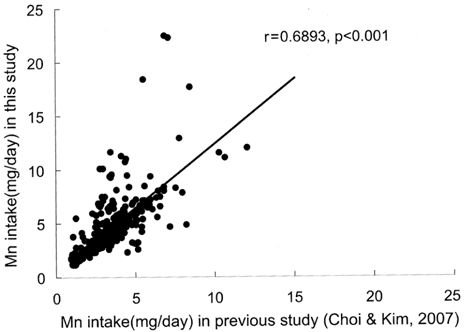Nutr Res Pract.
2008 Mar;2(1):22-25.
Estimation of manganese daily intake among adults in Korea
- Affiliations
-
- 1Department of Food and Nutrition, Sookmyung Women's University, Seoul 140-742, Korea.
- 2Department of Cosmetic Science, Chungwoon University, Chungnam 350-701, Korea.
- 3Department of Human Nutrition and Food Science, Chungwoon University, Chungnam 350-701, Korea. mkchoi@chungwoon.ac.kr
Abstract
- The purpose of this study was to estimate daily intake of manganese in Korean adults. Manganese intake was estimated through the use of the database of manganese content in frequently consumed Korean foods after first conducting anthropometric measurement and a survey on dietary intake with 354 Korean adults. Average age, height, weight and body mass index were 54.6 years, 165.7 cm, 67.2 kg and 24.5 kg/m2 in males and 53.8 years, 153.7 cm, 59.1 kg and 24.9 kg/m2 in females. The daily energy intakes of subjects were 1740.1 kcal in males and 1432.6 kcal in females. Male and female subjects recorded, respectively, 5.2 mg and 4.1 mg in manganese intake indicating that the male subjects consume more manganese (p<0.001). And they posted, respectively, 3.0 mg and 2.9 mg in manganese intake per 1000 kcal of energy consumption; it turned out that there was no significant difference. Daily manganese intake of both males and females posted, respectively, 148.8% and 135.2% of the adequate intake, and 8 males and 3 females surpassed the tolerable upper intake level. It is suggested that the study for accurate determination of manganese consumption needs to be more diversified based on the database of manganese content in Korean foods.
Figure
Reference
-
1. Cho YE, Lee SL, Cho EH, Lomeda RA, Kwak EH, Kim YH, Kwun IS. Comparison on nutrition intake of Korean elderly people living in rural area between 24-hour recall and food frequency method. Journal of Korean Society Food Science Nutrition. 2006. 35:698–707.2. Choi MK. Relationship between serum levels of microminerals and lipids in Korean adults on self-selected diet. Journal of Community Nutrition. 2000. 5:289–296.3. Choi MK, Kim EY. Evaluation of dietary manganese intake in Korean men and women over 20 years old. Journal of Korean Society Food Science Nutrition. 2007. 36:447–452.
Article4. Choi MK, Kim EY. The analysis of manganese contents in 366 Korean common foods. J Clinical Biochemistry and Nutrition. 2007. 41:168.5. Choi YH, Sung CJ. A study on nutrient intakes and serum levels of copper, zinc and manganese in Korean postmenopausal women with different bone mineral density. The Korean Journal of Nutrition. 2007. 39:485–493.6. Davis CD, Greger JL. Longitudinal changes of manganese-dependent superoxide dismutase and other indexes of manganese and iron status in women. Am J Clin Nutr. 1992. 55:747–752.
Article7. Diplock AT. Trace elements in human health with special reference to selenium. Am J Clin Nutr. 1987. 45:1313–1322.
Article8. Freeland-Graves JH, Turnlund JR. Deliberations and evaluations of the approaches, endpoints and paradigms for manganese and molybdenum dietary recommendations. J Nutr. 1996. 126:2435S–2440S.
Article9. Gibson RS. Content and bioavailability of trace elements in vegetarian diets. Am J Clin Nutr. 1994. 59:1223S–1232S.
Article10. Greger JL, Davis CD, Suttie JW, Lyle BJ. Intake, serum concentrations, and urinary excretion of manganese by adult males. Am J Clin Nutr. 1990. 51:457–461.11. Keen CL, Ensunsa JL, Watson MH, Baly DL, Donovan SM, Monaco MH, Clegg MS. Nutritional aspects of manganese from experimental studies. Neurotoxicology. 1999. 20:213–223.12. Klevay LM, Inman L, Johnson LK, Lawler M, Mahalko JR, Milne DB, Lukaski HC, Bolonchuk W, Sandstead HH. Increased cholesterol in plasma in a young man during experimental copper depletion. Metabolism. 1984. 33:1112–1118.
Article13. Kwak EH, Lee SL, Yoon JS, Lee HS, Kwun CS, Kwun IS. Macronutrient, mineral and vitamin intake in elderly people in the rural area of North Kyungpook province in South Korea. The Korean Journal of Nutrition. 2003. 36:1052–1060.14. Kim KH, Lim HS. Dietary intake, serum concentrations, and urinary excretions of Fe, Zn, Cu, Mn, Se, Mo, and Cr of Korean young adult women. The Korean Journal of Nutrition. 2006. 39:762–772.15. Malecki EA, Huttner DL, Greger JL. Manganese status, gut endogenous losses of manganese, and antioxidant enzyme activity in rats fed varying levels of manganese and fat. Biol Trace Elem Res. 1994. 42:17–29.
Article16. McLeod BE, Robonson MF. Metabolic balance of manganese in young women. Br J Nutr. 1972. 27:221–232.
Article17. Mertz W, Toepfer EW, Roginski EE, Polansky MM. Present knowledge of the role of chromium. Fed Proc. 1974. 33:2275–2280.18. National Rural Living Science Institute. Food composition tables. 2006. 7th ed. Seoul. Republic of Korea: Sangloksa.19. Patterson KY, Holbrook JT, Bodner JE, Kelsay JL, Smith JC Jr, Veillon C. Zinc, copper, and manganese intake and balance for adults consuming self-selected diets. Am J Clin Nutr. 1984. 40:1397–1403.
Article20. Schroeder HA. Relation between mortality from cardiovascular disease and treated water supplies: variations in states and 163 largest municipalities of the United States. J Am Med Assoc. 1960. 172:1902–1908.
Article21. Sung CJ, Yoon YH. The study of Zn, Cu, Mn, Ni contents of serum, hair, nail and urine for female college students. Journal of Korean Society Food Science Nutrition. 2000. 29:99–105.22. Suzuki Y. Table of trace element contents in Japanese foodstuffs. 1993. Tokyo. Japan: MAC.23. The Korean Nutrition Society. Dietary reference intakes for Koreans. 2005. Seoul. Republic of Korea:24. USDA. USDA Nutrient database for standard reference. 2003. USA: USDA;Release 18.
- Full Text Links
- Actions
-
Cited
- CITED
-
- Close
- Share
- Similar articles
-
- Daily Copper and Manganese Intakes and Their Relation to Blood Pressure in Normotensive Adults
- A Study on the Manganese Exposure and Health Hazard among Manganese Manufacturing Woman Workers
- A Study on the Validity of Filter Paper Method in Estimation of the Amount of Daily Salt Intake
- The estimated daily manganese intake of Korean children aged 11-12
- Daily Manganese Intake Status and Its Relationship with Oxidative Stress Biomarkers under Different Body Mass Index Categories in Korean Adults


